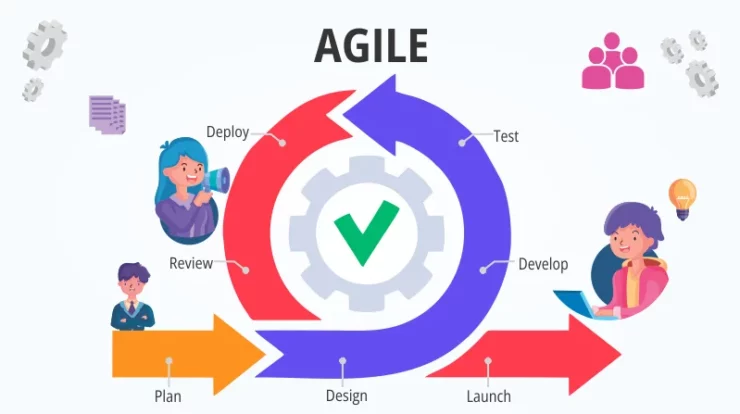
Because of the sometimes amazing advances in technology, things in the modern world tend to change quickly. Businesses are forced to review how they run their operations since business circumstances and customer demands are always changing. Moreover, failing to adapt to changes often leads to lagging behind your competitors. This article provides a thorough overview of the Agile SDLC.
This is especially true when talking about IT companies. To stay competitive and relevant, software development teams strive to provide high-quality products as quickly as possible. Additionally, they collaborate well to achieve their goals by quickly adjusting to market developments. The DeepInsipre team has shown how the Agile software development approaches, created specifically for quick software development, make this very achievable. As ardent supporters of agile SDLC software development, we have a lot to say about the methodology. Let’s go to work now.
What is the Agile Model?
A group of software experts who were dissatisfied with time-consuming, documentation-driven software development methods created the Agile Manifesto in 2001. The Agile Manifesto does not outline specific methodologies; instead, it puts forth the core principles and directives for Agile software development.
Numerous tactics and managerial approaches are based on the agile concept. The foundation of agile approaches is iterative development, in which projects are split up into smaller units known as sprints, each of which has a predetermined number, duration, and scope. Each iteration, which typically lasts one to four weeks, involves a team working through the whole software development lifecycle.
What Is the Agile Software Development Life Cycle, or SDLC?
Agile technology has already been used by 71% of businesses. By putting agile principles into practice, software developers have been able to boost productivity and provide more fulfilling outcomes. With the help of the agile software development life cycle, programmers may produce software fast, affordably, and in compliance with client requirements.
Agile SDLC places a strong emphasis on cooperation and enables participants to provide feedback and remarks about tasks. Each activity has a time limit, which facilitates everyone’s ability to fulfill deadlines and boost output. A sequential, linear approach is significantly less adaptable than the Agile SDLC. It is soliciting feedback from clients frequently to improve the output’s quality. The agile software development life cycle (SDLC) divides the development process into shorter cycles or sprints. These sprints result in more rapid and flexible software development.
According to the Agile Manifesto, the Agile SDLC is built around the following fundamental principles:
- Relationships between people are more significant than protocols and tools.
- Give functioning software more importance than documentation.
- collaborating when negotiating a contract
- Changing with the times
Customer feedback is collected after every sprint, allowing the team members to fix any areas where the client’s expectations are not met.
When and how may I use Agile?
Because one objective of agile SDLC development lifecycles is to continuously adjust the product development process to changing client or market needs, they are not suitable for use in projects that need to be implemented in line with highly strict requirements, such as legal or regulatory ones. The delivery timetable and implementation format of the final solution are usually fairly clear when such conditions are met. This suggests that if the project executor doesn’t comply, they might face fines and other consequences.
Agile SDLC Workflow Process
The fundamental units of the Agile SDLC are iterations, which typically run for two to four weeks. Agile process workflows frequently involve the following five steps:
- Identifying the requirements
- Development of products
- Software assessment
- Provision of iterations
- Remarks
Every stage of the Agile development lifecycle may include a large number of iterations, as developers might need to go through each step more than once to deliver faultless software and the best possible outcome. These iterations are minor cycles inside the wider Agile lifecycle.
The Agile SDLC Phases
Agility is embodied in the succession of phases that make up the software development lifecycle. The following are the phases of the Agile SDLC project lifecycle in DeepInspire:
Phase 1 of Agile: Exploration
The four stages of the Agile software development lifecycle are planning, analysis, exploration, and discovery. Through reviewing the given material, speaking with all project stakeholders, and conducting end-user interviews, the Discovery Team can obtain a comprehensive understanding of the business objectives, requirements, and difficulties of the clients.
The product owner, project manager, business analyst, and stakeholders make design decisions for the product during the next phase of discovery. They also select the development tools, including as frameworks, syntactic libraries, and programming languages, as well as the sequence in which functions are presented. During the design phase, agile SDLC teams often develop “proof of concept” solutions or even prototype the product’s user interface (UI).
The results of the discovery phase are the following deliverables:
- Described the basic requirements and scope of the project;
- Determined the cost and length of the project;
- Developed the UI/UX concept for the project and produced early wireframes and user interface concepts;
- Necessary features, suitable third-party solutions, the suggested technological stack and design, security recommendations, etc.
- I wrote the project charter and the product backlog, which are two of the most important project papers.
During the discovery phase, four professionals are assigned to the committed team for three weeks.
Phase 2 of Agile: Constructing
In the Agile software development lifecycle, the team may then start working on the project’s first iteration during the development phase. Coding, quality control for every update, architecture, and API development, and comprehensive UX/UI design for each screen and user flow are all included in the development process. The goal of every sprint used to deliver the product is to make the current iteration of the program better.
Phase 3 of Agile: Discharge
To make sure the application is fully functional, a pre-production release and a series of tests on the staging environment—a production replica—are required. This Agile SDLC step has been finished by the team.
- Investigate the many user-created features and procedures;
- Fixes defects and issues that were overlooked throughout the development phase;
- Maintains documents and carries out internal and external training;
- Assembles early feedback from project members.
This results in the completion of the iteration’s final release into production.
Phase 4 of Agile: Manufacturing
Users may now access and completely install the software. At this point in the Agile software development lifecycle, it’s crucial to keep an eye out for any errors or problems that can be missed, and end users’ feedback can be a great place to get inspiration for new features.
Phase 5 of Agile: Maintenance
An agile software development phase follows the product’s release. Agile SDLC approaches state that the Agile team should provide continuing support to fix any issues and keep the system operating. To provide the product with more features, iterations can also be developed again.
Phase 6 of Agile: Retirement
The system release is pulled out of service during the retirement phase, either because you want to replace it with a new release or because it is superfluous or no longer matches your business model.
Advantages of the Agile SDLC Framework
Using the Agile lifecycle model, teams can produce 80% of the product 20% of the time, but that’s not all. Putting the Agile philosophy into practice has definite advantages. Let’s take a closer look at them.
Increased efficacy in mitigating risks
- Using the Agile process significantly reduces the chance that the software project will fail. Agile software development teams prioritize continuous delivery and often work in small sprints. Throughout the sprints, developers closely monitor the project’s progress and can identify any potential issues early on. When issues are fixed before they worsen, the project has a higher chance of success.
Higher customer satisfaction and improved product quality
- Testing is a crucial part of every sprint to accurately track quality and eliminate errors from the finished product. Additionally, by keeping the client updated on the project’s status and scheduling frequent meetings, agile project management helps to avoid misconceptions. Furthermore, the Agile SDLC technique is based on continuous feedback and collaboration, which helps developers find and fix bugs faster and enhance the code as it is being developed, resulting in high-quality software.
Improved communication
- Agile software development teams need to be in continual contact and face-to-face interaction. Agile SDLC approaches advise daily standups to make sure that everyone is working toward the same objectives and that everything is functioning as it should. This makes misunderstandings less likely and makes achieving goals easier. Customer connection is essential, despite the Agile process’s requirement for regular input. At DeepInspire, for instance, we have daily catch-up talks and weekly status calls with the representatives of our clients.
Process flexibility and adaptability
- Agile teams are incredibly adaptable and can swiftly change their processes to meet shifting goals. This enables the Agile SDLC team to handle their clients’ changing demands efficiently and reliably.
More practical measures
- In software development, metrics are crucial for cost estimation, management, debugging, quality assurance, and performance evaluation. They may be used to recognize, prioritize, track, and communicate any issues to improve team productivity. Agile methodologies employ a range of metrics that are more precise and relevant than those found in more antiquated methods like the waterfall model. Agile focuses on achieving results and optimizing performance, whereas waterfall model metrics translate project performance to the anticipated cost and time ratio.
Adaptable Frameworks
- An approach to software development that has its foundations in the Agile notion is the Agile SDLC framework. Agile processes or approaches are often referred to as Agile frameworks. Still, most Agile teams only modify frameworks to fit their needs and use them as the starting point for their Agile transformation.
Scrum, Adaptive Software Development (ASD), Extreme Programming (XP), Scaled Agile Framework (SAFe), Rapid Application Development (RAD), Dynamic Systems Development Method (DDSM), and a few more are among the most well-known agile development frameworks.
Five Ways to Increase Software Development Agility
Optimizing team performance is the aim of the agile development cycle. Technology, infrastructure, automation, methodology, and architecture are the five primary pillars of the Agile SDLC. These pillars promote quickness and dexterity.
It’s essential to truly evaluate where your company is in each area. Are you ready to change to meet changing company needs? If you are not as mature as you may be in a certain area right now, you have more opportunities to improve.
Let’s look at each of the five focus areas and provide some recommendations.
- Methods: help expedite project discovery, improve business and IT collaboration, and ensure a quicker time to value. Promoting quick adjustments in response to changing company needs improves speed and adaptability at every level.
- Structures: Create your solutions by applying the ideas of microservices or component-based architecture. With this approach, teams may create autonomous and independent systems that are more adaptable and reduce the impact of change.
- Automation: Manual work is labor-intensive and error-prone. Start by timing how long each manual task takes, and then automate the tasks that take the longest.
- Infrastructure: Teams with adaptable infrastructures are more adept at coping with constant change. Many IaaS companies currently provide instantaneous server deployment. The next step is containerization, which when coupled with automation, may lead to fully automated provisioning as well as self-service.
- Technology: Technology will finally provide agility. To maximize value, the right technology must be chosen for the job. When choosing your areas of focus, consider your core company objectives. Select a tool that will help you achieve your goals with the least amount of effort.
Make sure the technologies you select complement one another and help you become more nimble. Choose open technology that will grow with you and accelerate your SDLC’s agility.
What function does DevOps serve?
Using DevOps tools and practices does not guarantee agile development for a firm. Each phase in the Agile software development process has a specific goal, and achieving those goals necessitates a tactical approach.
DevOps teams may thrive and work together with Agile SDLC on low-code development platforms. Agile was taken into mind when the Mendix low-code Platform was designed. Moreover, there exist alternative approaches to incorporate Mendix into your existing workflows:
- Connect your existing Agile requirements suite.
- Utilize the Agile toolbox that has been incorporated.
- Use Mendix Cloud to activate your apps.
To sum up:
In the quickly evolving world of technology, the Agile SDLC (Software Development Life Cycle) is transforming software development and how organizations approach it. Because technology is improving at a quick pace and because corporate environments and customer expectations are always changing, it is necessary to have a flexible and adaptable approach. To be competitive, IT companies need to be able to deliver high-quality products fast and adapt to shifting market conditions. This demand gave rise to the Agile software development methodologies, the effectiveness of which is demonstrated by the DeepInspire team.
The staff at DeepInspire is a fervent supporter of the Agile approach and recognizes the value of adaptability in overcoming the obstacles faced by modern software development. The Agile Manifesto states that agile is more than just a set of methods; it is a way of thinking that is founded on core principles and concepts. It provides a foundation for many approaches and methods of management that facilitate iterative development. Work is divided into digestible sprints or iterations according to the Agile approach; each has a predetermined number, duration, and scope. Each iteration, which typically lasts one to four weeks, allows teams to complete the software development lifecycle with an emphasis on collaboration and flexibility.
In summary, the Agile Software Development Life Cycle (SDLC) has become a vital element for success in the demanding world of software development. It enables teams to manage uncertainty, swiftly adjust to shifting needs, and deliver value to customers. As technology develops, the Agile notion remains a ray of hope for teams who want to drive software innovation rather than just follow it.
FAQs:
1. What Is the Agile Software Development Process?
Agile software development is the umbrella term for a set of methods and approaches that prioritize collaboration, adaptability, and iterative development. It was created in response to the need for more flexible and quick software development processes.
2. When was Agile Software Development first introduced?
Agile software development began with the Agile Manifesto, which was created in 2001 by a group of software developers. While establishing the core principles and rules of agile SDLC, the manifesto emphasizes adaptability and client participation.
3. What is included in the Agile Manifesto?
The Agile Manifesto is the foundational document for agile software development. It outlines twelve guiding principles and four fundamental values that prioritize connections between people, workable solutions, and customer collaboration over processes and tools.
4. In what ways is Agile SDLC applied?
The agile SDLC is based on iterative development, which splits work into shorter iterations or sprints. An iteration’s length, number, and scope are all specified, and its usual duration is one to four weeks. Teams can use this strategy to gradually provide software and adapt to changing requirements.
5. Why is agility important to IT companies?
Agile is critical to IT firms because it enables them to maintain their competitiveness and produce high-quality products rapidly. It makes it possible for groups to collaborate effectively to achieve goals, quickly adapt to market developments, and shift course in response to evolving customer needs.
6. What benefits arise from using the Agile methodology?
The agile methodology offers several benefits, including a reduced time to market, adaptability in adapting to evolving requirements, improved collaboration, and the ability to provide clients with more value. It promotes a flexible and customer-focused approach to software development.
Also Read Top 20 MVP Software Development Agencies: What is it?







